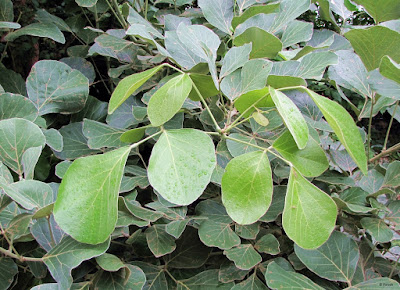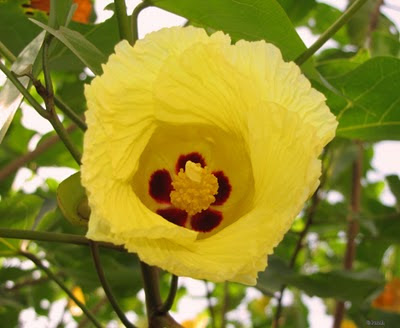It is a very famous ornamental tree. But very few know that the tree can be a very good Agroforestry tree as well. Golden Champa (Michelia Champaca/सोनचाफा) is an evergreen tree and mainly cultivated for its strongly fragrant yellow or white flowers.
The flowers of Golden Champa are best known and used in India for several purposes. They are primarily used for worship at temples, floated in bowls of water to scent the room, as a fragrant decoration for bridal beds, for garlands, in religious ceremonies and generally worn in hair by women as a means of beauty ornament as well as a natural perfume. A yellow dye is extracted from the flowers and is used as a base for other colours. The flower is the main scent present in the commercial 'Joy' perfume, most expensive perfume in the world; hence sometimes is called as Joy Perfume tree.
Golden Champa is a very useful agroforestry tree too! It is known to fix the atmospheric nitrogen in soil with the help of vesicular-arbuscular mycorrhizae. Its leaves provide very useful mulch. It improves the soil under tree cover by increasing pH, soil organic carbon and available phosphorus. Hence it is used to reforest badly eroded areas. Its leaves are used as larval fodder by silkworms & butterflies. It has potential for commercial exploitation for oil production for various uses. Other uses includes as a wayside tree & near temples for ornamental. The tree is seldom cut on account of it being considered as sacred. It can be propagated by seeds but seeds should be sown as soon as possible after collection.
 The tree also possesses medicinal properties. Leafs extract and seeds extracts shows fungicidal & antibacterial activity respectively. A decoction of the bark and leaves is given after childbirth; the bark is used as a febrifuge. In Ayurveda, the tree is mentioned to pacify vitiated tridosha, detoxify poison, worm infestation, increase digestive power, diuretic and cures fever. Flowers reduce burning sensation, cures skin disease, even leprosy & ulcer.
The tree also possesses medicinal properties. Leafs extract and seeds extracts shows fungicidal & antibacterial activity respectively. A decoction of the bark and leaves is given after childbirth; the bark is used as a febrifuge. In Ayurveda, the tree is mentioned to pacify vitiated tridosha, detoxify poison, worm infestation, increase digestive power, diuretic and cures fever. Flowers reduce burning sensation, cures skin disease, even leprosy & ulcer.
These are flowers you don't have to stick your nose in as the scent can be enjoyed several hundred feet away from the tree, even while driving by the tree. However, you really can't stop sticking your nose into a flower over and over again. Nectar insects & butterflies appear frantic, driven like drug addicts, bashing into each other to get to the heart of every flower on the tree. The extremely aromatic orange blooms & fruits appear nearly all year round. Its aril-covered seeds are highly attractive to birds & squirrels.
Planting a Golden Champa tree in your backyard really makes your home a sweet home. Also you could take the flower, home made natural perfume. It emits a unique warm fragrance which promotes a peaceful state of mind, reducing stress and allowing one to relax and breathe easily. Looks like it is specially designed for moments of tranquil contemplation. Its the nature of Champa to remind us of the Divine in all things.
The flowers of Golden Champa are best known and used in India for several purposes. They are primarily used for worship at temples, floated in bowls of water to scent the room, as a fragrant decoration for bridal beds, for garlands, in religious ceremonies and generally worn in hair by women as a means of beauty ornament as well as a natural perfume. A yellow dye is extracted from the flowers and is used as a base for other colours. The flower is the main scent present in the commercial 'Joy' perfume, most expensive perfume in the world; hence sometimes is called as Joy Perfume tree.
Golden Champa is a very useful agroforestry tree too! It is known to fix the atmospheric nitrogen in soil with the help of vesicular-arbuscular mycorrhizae. Its leaves provide very useful mulch. It improves the soil under tree cover by increasing pH, soil organic carbon and available phosphorus. Hence it is used to reforest badly eroded areas. Its leaves are used as larval fodder by silkworms & butterflies. It has potential for commercial exploitation for oil production for various uses. Other uses includes as a wayside tree & near temples for ornamental. The tree is seldom cut on account of it being considered as sacred. It can be propagated by seeds but seeds should be sown as soon as possible after collection.
 The tree also possesses medicinal properties. Leafs extract and seeds extracts shows fungicidal & antibacterial activity respectively. A decoction of the bark and leaves is given after childbirth; the bark is used as a febrifuge. In Ayurveda, the tree is mentioned to pacify vitiated tridosha, detoxify poison, worm infestation, increase digestive power, diuretic and cures fever. Flowers reduce burning sensation, cures skin disease, even leprosy & ulcer.
The tree also possesses medicinal properties. Leafs extract and seeds extracts shows fungicidal & antibacterial activity respectively. A decoction of the bark and leaves is given after childbirth; the bark is used as a febrifuge. In Ayurveda, the tree is mentioned to pacify vitiated tridosha, detoxify poison, worm infestation, increase digestive power, diuretic and cures fever. Flowers reduce burning sensation, cures skin disease, even leprosy & ulcer.These are flowers you don't have to stick your nose in as the scent can be enjoyed several hundred feet away from the tree, even while driving by the tree. However, you really can't stop sticking your nose into a flower over and over again. Nectar insects & butterflies appear frantic, driven like drug addicts, bashing into each other to get to the heart of every flower on the tree. The extremely aromatic orange blooms & fruits appear nearly all year round. Its aril-covered seeds are highly attractive to birds & squirrels.
Planting a Golden Champa tree in your backyard really makes your home a sweet home. Also you could take the flower, home made natural perfume. It emits a unique warm fragrance which promotes a peaceful state of mind, reducing stress and allowing one to relax and breathe easily. Looks like it is specially designed for moments of tranquil contemplation. Its the nature of Champa to remind us of the Divine in all things.




















































